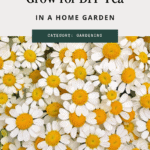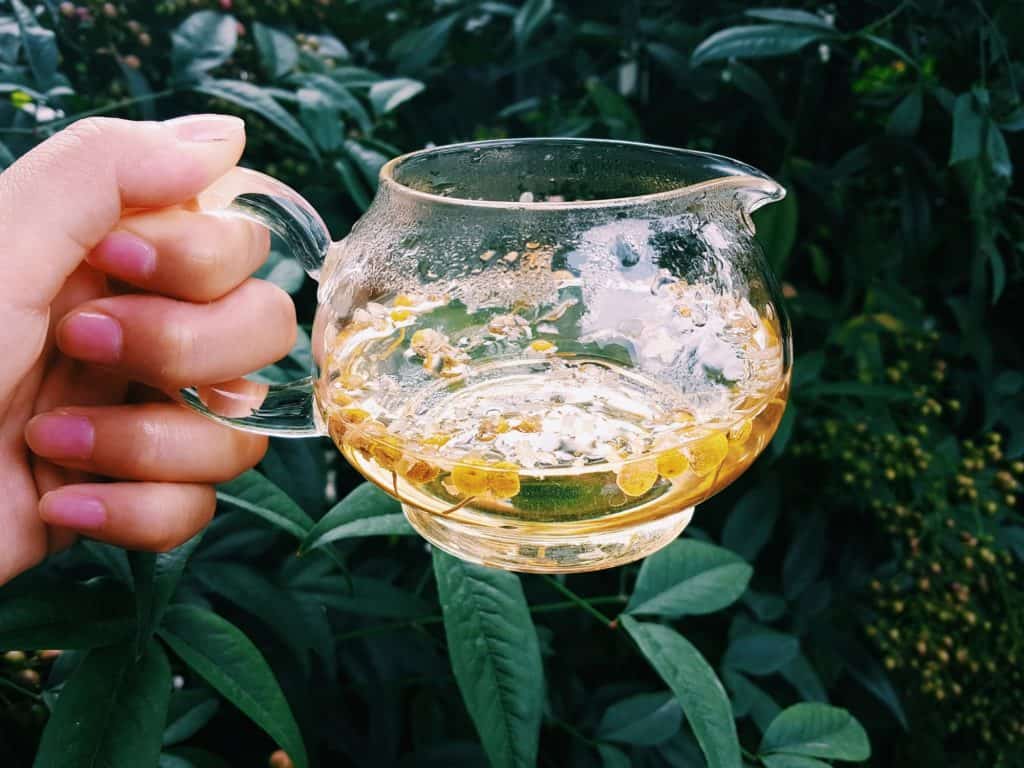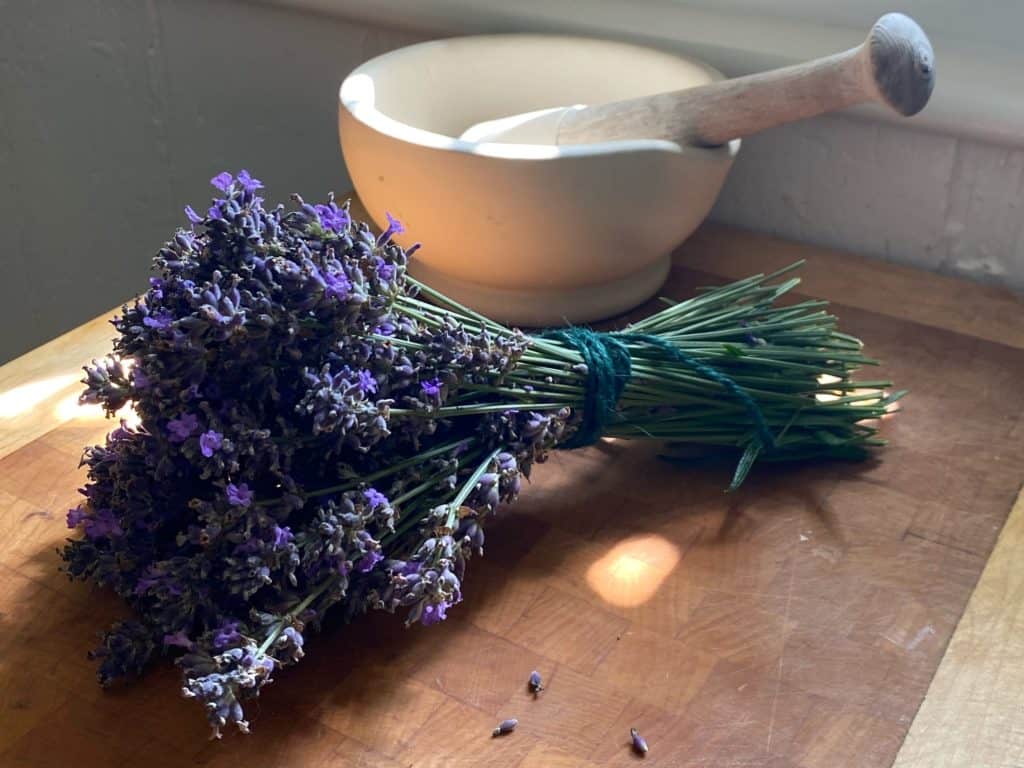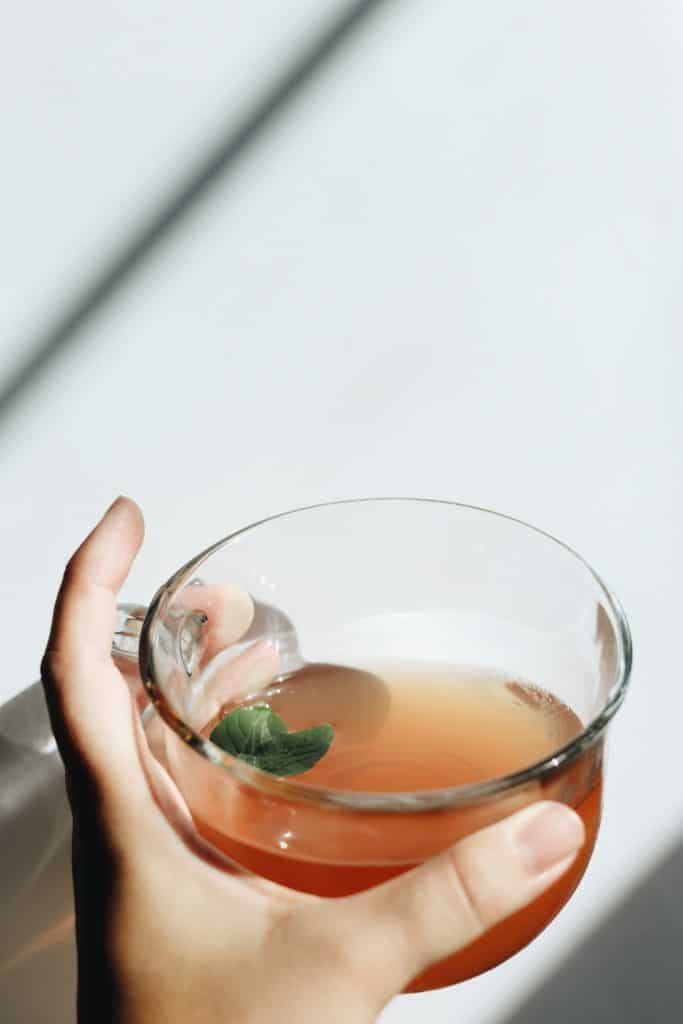
If you love tea, there’s no reason not to grow your own tea garden. Not only will you have access to fresher, more flavorful tea ingredients, but you’ll also be able to save money in the long run.
Here are 9 flowers and herbs that make great additions to any homegrown tea garden:
Affiliate Disclosure: Some of the links in this post are affiliate links. This means that if you click on the link and purchase an item, I will receive a commission at no extra cost to you. I only recommend stuff I love and would recommend to a friend.
1. Chamomile
 Pin
PinChamomile tea is a popular choice for its calming and relaxing properties. Chamomile tea can be made with either fresh or dried chamomile flowers, though it’s recommended to use dried flowers.
Dried chamomile flowers can have a stronger flavor and it’s easier to store large amounts of dried chamomile for having tea throughout the year.
A few modern studies have shown that it’s possible that chamomile helps with insomnia, anxiety, and digestive troubles.
If you plan to grow chamomile for tea, your best bet as a beginner is German chamomile.
This chamomile is relatively easy to grow and it’s the most commonly used in chamomile teas, so it will taste similar to what you’d expect it to, except much better since it’ll be fresher and from your own garden.
2. Hibiscus
Hibiscus tea is rich in antioxidants. More studies are needed, but it’s possible that hibiscus tea could help lower blood pressure and improve liver health. Pretty cool stuff.
I can’t grow hibiscus in my growing zone without a lot of environmental modification, but you might be able to! I order hibiscus for tea online.
If you want to grow hibiscus, you’ll have the best success in warmer growing zones with decently high humidity levels. Growing hibiscus from cuttings is significantly easier than from seed, so consider buying a plant or some cuttings to add hibiscus to your garden.
3. Lavender
 Pin
PinLavender tea is a soothing and calming tea that is made with either fresh or dried lemon insomnia. Lavender tea can be made with either fresh or dried lavender flowers.
Lavender mixes well with citrus flavors like lemon and orange, but it also states surprisingly good with pineapple and peach-flavored teas. It’s commonly mixed with other botanical flavors, like rose.
Growing lavender from seeds can be tricky, but once it’s bigger it’s pretty easy to manage. It’s a perennial in zones 7-9, so if you’re there, you’ll be able to plant once and harvest for years to come.
If you’re growing somewhere else, you can buy a plant from a local nursery as an annual or try growing it from seed. (If you do, don’t forget to cold-stratify them for better germination rates!)
4. Lemon Balm
Lemon balm tea is a refreshing and invigorating tea that can help with indigestion, anxiety, and insomnia. Lemon balm tea can be made with either fresh or dried lemon balm leaves.
Lemon balm seeds can be more difficult to germinate, similar to lavender. What I did, was put the seeds on a damp paper towel and set them in the fridge for 4 weeks to cold stratify.
After 4 weeks is up, take them out of the fridge and let them come to room temperature. They will sprout into the paper towels and you can plant the sprouts.
Or, just take the seeds out after they’re at room temperature and plant them as you normally would.
Cold stratification increases germination in some seeds because it models winter and makes the seeds think it’s time to germinate when they come out of the fridge.
Highly recommend trying it out for any spring seeds that have been difficult for you to sprout.
5. Mint
Mint tea is a refreshing and cooling tea that can help with indigestion and nausea. It’s one of my favorite teas to drink and there are so many cool variations of mint to grow.
Right now, I’m growing a strawberry mint that’s doing so well in my garden and I’m really excited to try it in tea.
You can make tea with just your mint leaves or mix it with other herbs and spices to make a custom tea blend.
Some great combos are:
- Peach mint
- Strawberry mint
- Lemon mint
- Lime mint
- Mint and lavender
- Cucumber mint
- Chocolate mint
- Mint + lemongrass + lemon balm
- Rasberry mint
- Watermelon mint
And that’s only the beginning when it comes to mint teas. It goes well with soooo many flavors.
Mint also has dozens of culinary uses and it’s just a great plant overall to have in your garden.
Try to keep it contained if you’re worried about it becoming invasive, though! Mint can easily take over your whole garden.
6. Nettle
Nettle tea is a nutrient-rich tea that might help with allergies, arthritis, and anxiety.
Nettle is considered a weed in many places, so it’s pretty easy to grow and if you don’t already have it growing in your yard, it’s a great addition to a medicinal herb garden.
If you don’t want the nettle to spread (this is definitely best if you have kids, because it can sting) try growing it in a large pot or raised bed to contain it easier.
Plant nettle seeds indoors in small pots with 1-3 seeds per pot. Keep the seeds moist and they should germinate within two weeks.
Alternatively, direct sow them outside once your last spring frost has passed, or dig up a few nettle plants from a friend’s yard and replant them in yours (With permission, of course 🤣)
7. Rosemary
Rosemary tea is a delicious and fragrant tea that can help with memory and concentration. It’s also high in antioxidants, may help lower your blood sugar, and may support brain health.
Check out this evidence-based article from Healthline for more information about the benefits of rosemary and rosemary teas.
Obviously, there are other benefits to growing rosemary since it’s an amazing culinary herb, but it brings a wonderful flavor to teas and I’d highly recommend trying it in tea if you can.
You can mix many other flavors with rosemary to get a super unique tea. Rosemary mint tea is one of my favs, but you can also mix it with lemon and ginger for a spicier tea blend.
Rosemary can grow quite a lot of sprigs for you in the garden which means that you’ll likely have an abundance of it if you do grow it.
And this is one of the many ways you can use that rosemary so that it doesn’t go to waste. Unlike some herbs, you can use both the leaves and the stems for making tea.
8. Thyme
 Pin
PinThyme tea is a flavorful and aromatic tea that can help with coughs and sore throats. It’s another culinary herb that’s popular in meat-based dishes and soups of all kinds and it’s pretty easy to grow in a home garden, in the ground, or in a container.
It doesn’t necessarily need a lot of sun to grow, either. Partial sun (3-4 hrs) of direct sunlight per day is usually enough for thyme to thrive, but it also loves the sun and will happily accept full sun positions in your garden.
Cool thing: Thyme can be used as a groundcover/lawn alternative in some areas. I’m growing creeping thyme for my lawn at the moment. If you’re interested in replacing your lawn with a more eco-friendly groundcover, check out this list of better-for-the-planet alternatives to lawn grass.
Thyme is a fairly hardy perennial and it can do well in dry, somewhat rocky conditions where other herbs might struggle.
There are a ton of varieties of thyme out there, but if you’re looking for common thyme to cook and make tea with, you want what’s called English thyme and you can buy it almost anywhere that sells seeds. If you really want to get crazy, try lemon thyme or orange basalm thyme.
9. Yarrow
 Pin
PinYarrow tea is a bitter and astringent tea that can help with colds and flu. Yarrow is best sown in small pots indoors and planted outside once you’ve got a pot full of little plants with true leaves.
Yarrow can grow in many climates and doesn’t mind arid, dry climates with poor soil, like in Colorado, for example.
It’s another herb that you might want to keep contained in a pot so that it doesn’t become invasive. I planted a variety of Yarrow native to my area straight into the ground.
In terms of possible health benefits from yarrow tea, there are a few worth mentioning.
Yarrow has been used as a medicinal herb for over 60,000 years. Reported benefits include help with bleeding from minor wounds, relief from inflammatory conditions like arthritis, and help with muscle cramps.
That’s only the beginning of the list of medicinal uses for yarrow, though. Check out this list for some more.
Try adding some honey and/or lemon to your yarrow tea if you’re not a fan of the flavor alone.
Drying and storing herbs and flowers for teas all year long
Tie the herb heads together and hang them upside down in a cool, dark location to dry the leaves.
You can then take your dried herbs and store them in an airtight jar or another food-safe container.
To make any of these teas, simply steep 1-2 teaspoons of the dried herb in 8 ounces of boiling water for 5-10 minutes.
From there, try adding things and blending flavors to make your own tea blends. Or, search around online for more herbal tea recipes you can make with your homegrown herbs. This is just the very tip of the iceberg.
Where to buy seeds for a home tea garden
Anywhere will work, really!
But here’s some links to some of my favorite online seed shops. All have fair prices and I’ve personally had success with each of these seed companies.
And for something to plant your seeds in, I love these Bootstrap Farmer growing cells and trays. They’re way stronger than the random ones I bought on Amazon when I was first starting my gardening journey.
DIY tea gardens are a great way to have access to fresh, flavorful, and healthy teas year-round. Not to mention, they can save you money in the long run.
Happy herb gardening!
 Pin
Pin
